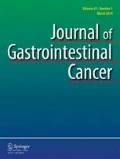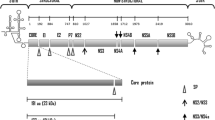Abstract
Background
Hepatocellular carcinoma (HCC) is the fifth most common cancer, the third leading cause of cancer deaths worldwide with over 500,000 people affected. It is a major cause of death in patients with chronic hepatitis C virus (HCV) infection. Overwhelming lines of epidemiological evidence have indicated that persistent infection with HCV is a major risk for the development of HCC. Although a proportion of patients with a chronic hepatitis C virus infection progress to HCC, the peak incidence of HCC associated with HCV infection has not yet occurred.
Aim
This review aimed to assess the impact of hepatitis C viral load on the development of HCC as a correlation between mir-122 and, the key factor in fibrogenesis, CCL2.
Conclusion
According to the detailed explanation of the role of mir-122 and CCL2 in HCV and HCC and the evidence of the inverse correlation between them, it may be concluded that HCV may affect mir-122 expression level of the hepatocytes with different patterns depending on the viral genotype. Collectively, HCV viral load alone is not sufficient to predict the HCC development and progression. Besides the quantitative evaluation of the HCV, mir-122 and CCL2 determinations should also be taken into consideration.





Similar content being viewed by others
References
Siegel RL, Miller KD, Jemal A. Cancer statistics, 2015. CA Cancer J Clin. 2015;65:5–29.
Ghouri YA, Mian I, Rowe JH. Review of hepatocellular carcinoma: epidemiology, etiology, and carcinogenesis. J Carcinog. 2017;16:1.
Yahya SM, Fathy SA, El-Khayat ZA, El-Toukhy SE, Hamed AR, Hegazy MG, et al. Possible role of microRNA-122 in modulating multidrug resistance of hepatocellular carcinoma. Indian J Clin Biochem. 2017;33:21–30.
El-Toukhy SE, Fathy SA, Yahya SM, El-Khayat ZA, Hegazy MG, Heba K. Nabih. MicroRNA-122 restoration modulates alpha-fetoprotein expression in hepatocellular carcinoma treated with doxorubicin. Pharm Lett. 2016;8:29–35.
Castoldi M, Vujic Spasic M, Altamura S, Elmen J, Lindow M, Kiss J, et al. The liver-specific microRNA miR-122 controls systemic iron homeostasis in mice. J Clin Invest. 2011;121:1386–96.
Hu J, Xu Y, Hao J, Wang S, Li C, Meng S. MiR-122 in hepatic function and liver diseases. Protein Cell. 2012;3:364–71.
Song K, Han C, Zhang J, Lu D, Dash S, Feitelson M, et al. Epigenetic regulation of miR-122 by PPARγ and hepatitis B virus X protein in hepatocellular carcinoma cells. Hepatology. 2013;58:1681–92.
Varnholt H, Drebber U, Schulze F, Wedemeyer I, Schirmacher P, Dienes HP, et al. MicroRNA gene expression profile of hepatitis C virus-associated hepatocellular carcinoma. Hepatology. 2008;47(4):1223e1232.
El-Garem H, Ammer A, Shehab H, Shaker O, Anwer M, El-Akel W, et al. Circulating microRNA, miR-122 and miR-221 signature in Egyptian patients with chronic hepatitis C related hepatocellular carcinoma. World J Hepatol. 2014;6(11):818e824.
Wen J, Friedman JR. miR-122 regulates hepatic lipid metabolism and tumor suppression. J Clin Invest. 2012;122(8):2773–6.
Tacke F. Targeting hepatic macrophages to treat liver diseases. J Hepatol. 2017;66:1300–12.
Li X, Yao W, Yuan Y, Chen P, Li B, Li J, et al. Targeting of tumour-infiltrating macrophages via CCL2/CCR2 signalling as a therapeutic strategy against hepatocellular carcinoma. Gut. 2017;66:157–67.
Zhuang H, Cao G, Kou C, Liu T. CCL2/CCR2 axis induces hepatocellular carcinoma invasion and epithelial-mesenchymal transition in vitro through activation of the Hedgehog pathway. Oncol Rep. 2018;39:21–30.
Tang Y, Jia W, Niu X, Wu L, Shen H, Wang L, et al. CCL2 is upregulated by decreased miR-122 expression in iron-overload-induced hepatic inflammation. Cell Physiol Biochem. 2017;44:870–83.
Lavanchy D. The global burden of hepatitis C. Liver Int. 2009;29:74–81.
Lavanchy D. Evolving epidemiology of hepatitis C virus. Clin Microbiol Infect. 2011;17:107–15.
Fahey S, Dempsey E, Long A. The role of chemokines in acute and chronic hepatitis C infection. Cell Mol Immunol. 2014;11:25–40.
Asselah T, Bieche I, Laurendeau I, Paradis V, Vidaud D, Degott C, et al. Liver gene expression signature of mild fibrosis in patients with chronic hepatitis C. Gastroenterology. 2005;129:2064–75.
Zhdanov KV, Gusev DA, Chirskii VS, Sysoev KA, Iakubovskaia LA, Shakhmanov DM, et al. Chronic HCV-infection and expression of mRNA of CC-chemokines and their receptors. Zhurnal Mikrobiol Epidemiol Immunobiol. 2008;4:73–8. (In Russian). [https://www.ncbi.nlm.nih.gov/pubmed/18822499].
Lemon SM, Walker C, Alter MJ, Yi MK. Hepatitis C viruses. In: Knipe D, Howley P, editors. Fields virology. 5th ed. Philadelphia: Lippincott Williams & Wilkins; 2007.
Jopling CL, Schutz S, Sarnow P. Position dependent function for a tandem microRNA miR122 binding site located in the hepatitis C virus RNA genome. Cell Host Microbe. 2008;4(1):7785.
García-Sastre A, Evans MJ. miR-122 is more than a shield for the hepatitis C virus genome. PNAS. 2013;110:1571–2.
Shimakami T, Yamane D, Jangra RK, Kempf BJ, Spaniel C, Barton DJ, et al. Stabilization of hepatitis C virus RNA by an Ago2 miR122 complex. Proc Natl Acad Sci U S A. 2012;109(3):9416.
Spaniel C, Honda M, Selitsky SR, Yamane D, Shimakami T, Kaneko S, et al. microRNA-122 abundance in hepatocellular carcinoma and non-tumor liver tissue from Japanese patients with persistent HCV versus HBV infection. PLoS One. 2013;8(10):e76867.
Murakami Y, Yasuda T, Saigo K, Urashima T, Toyoda H, Okanoue T, et al. Comprehensive analysis of microRNA expression patterns in hepatocellular carcinoma and non-tumorous tissues. Oncogene. 2006;25(17):2537–45.
Karakatsanis A, Papaconstantinou I, Gazouli M, Lyberopoulou A, Polymeneas G, Voros D. Expression of microRNAs, miR-21, miR-31, miR-122, miR-145, miR-146a, miR-200c, miR-221, miR-222, and miR-223 in patients with hepatocellular carcinoma or intrahepatic cholangiocarcinoma and its prognostic significance. Mol Carcinog. 2013;52(4):297–303.
Harouaka D, Engle RE, Wollenberg K, Diaz G, Tice AB, Zamboni F, et al. Diminished viral replication and compartmentalization of hepatitis C virus in hepatocellular carcinoma tissue. PNAS. 2016;113(5):1375–80.
Kobayashi S, Hayashi H, Itoh Y, Asano T, Isono K. Detection of minus-strand hepatitis C virus RNA in tumor tissues of hepatocellular carcinoma. Cancer. 1994;73(1):48–52.
Sobesky R, Feray C, Rimlinger F, Derian N, Santos AD, Roque-Afonsoet A, et al. Distinct hepatitis C virus core and F protein quasispecies in tumoral and nontumoral hepatocytes isolated via microdissection. Hepatology. 2007;46(6):1704–12.
Ishiguro S, Inoue M, Tanaka Y, Mizokami M, Iwasaki M, Tsugane S. Impact of viral load of hepatitis C on the incidence of hepatocellular carcinoma: a population-based cohort study (JPHC study). Cancer Lett. 2011;300(2):173–9.
Lee MH, Yang HI, Lu S, Jen C, Yeh S, Liu C, et al. Hepatitis C virus seromarkers and subsequent risk of hepatocellular carcinoma: long-term predictors from a community-based cohort study. J Clin Oncol. 2010;28(30):4587–93.
Lee CM, Hung CH, Lu SN, Wang JH, Tung HD, Huang WS, et al. Viral etiology of hepatocellular carcinoma and HCV genotypes in Taiwan. Intervirology. 2006;49:76–81.
Ikeda K, Kobayashi M, Someya T, Saitoh S, Tsubota A, Akuta N, et al. Influence of hepatitis C virus subtype on hepatocellular carcinogenesis: a multivariate analysis of a retrospective cohort of 593 patients with cirrhosis. Intervirology. 2002;45(2):71–8.
Bruno S, Silini E, Crosignani A, Borzio F, Leandro G, Bono F, et al. Hepatitis C virus genotypes and risk of hepatocellular carcinoma in cirrhosis: a prospective study. Hepatology. 1997;25(3):754–8.
Silini E, Bottelli R, Asti M, Bruno S, Candusso ME, Brambilla S, et al. Hepatitis C virus genotypes and risk of hepatocellular carcinoma in cirrhosis: a case-control study. Gastroenterology. 1996;111(1):199–205.
Cho EJ, Jeong SH, Han BH, Lee SU, Yun BC, Park ET. Hepatitis C virus (HCV) genotypes and the influence of HCV subtype 1b on the progression of chronic hepatitis C in Korea: a single center experience. Clin Mol Hepatol. 2012;18(2):219–24.
Mangia A, Cascavilla I, Lezzi G, Spirito F, Maertens G, Parlatore L, et al. HCV genotypes in patients with liver disease of different stages and severity. J Hepatol. 1997;26(6):1173–8.
Yotsuyanagi H, Koike K, Yasuda K, Moriya K, Hino K, Kurokawa K, et al. Hepatitis C virus genotypes and development of hepatocellular carcinoma. Cancer. 1995;76(8):1352–5.
Kim GW, Lee SH, Cho H, Kim M, Shin EC, Oh JW. Hepatitis C virus core protein promotes miR-122 destabilization by inhibiting GLD-2. PLoS Pathog. 2016;12(7):e1005714.
Luna JM, Scheel TK, Danino T, Shaw KS, Mele A, Fak JJ, et al. Hepatitis C virus RNA functionally sequesters miR-122. Cell. 2015;160:1099–110.
Amr KS, Atia HA, Elbnhawy RA, Ezzat WM. Early diagnostic evaluation of miR-122 and miR-224 as biomarkers for hepatocellular carcinoma. Genes & Diseases. 2017;4:215e221.
Ghoneim EM, Abed El-Aziz AM, Abd El-Mottaleb TM, El-Hendawy GR, El-Ezawy HM, Khalil FO. Profiling of microRNA-122 in chronic hepatitis C. Menoufia Med J. 2016;29:826–34.
Sun C, Farzadegan H, You S, Lu S, Wu M, Wolfe L, et al. Mutual confounding and interactive effects between hepatitis C and hepatitis B viral infections in hepatocellular carcinogenesis: a population-based case-control study in Taiwan. Cancer Epidemiol Biomark Prev. 1996;5(3):173–8.
Yates SC, Hafez M, Beld M, Lukashov VV, Hassan Z, Carboni G, et al. Hepatocellular carcinoma in Egyptians with and without a history of hepatitis B virus infection: association with hepatitis C virus (HCV) infection but not with HCV RNA level. Am J Trop Med Hyg. 1999;60(4):714–20.
Duvoux C, Pawlotsky J, Bastie A, Cherqui D, Soussy C, Dhumeaux D. Low HCV replication levels in end-stage hepatitis C virus-related liver disease. J Hepatol. 1999;31(4):593–7.
Noh R, Lee DH, Kwon BW, Kim YH, Kim SB, Song IH. Clinical impact of viral load on the development of hepatocellular carcinoma and liver-related mortality in patients with hepatitis C virus infection. Gastroenterol Res Pract 2016:7476231. Hindawi Publishing Corporation. [https://doi.org/10.1155/2016/7476231].
Author information
Authors and Affiliations
Contributions
Heba K. Nabih designed, drafted, and revised the manuscript.
Corresponding author
Ethics declarations
This investigation has complete compliance with ethical standards.
Conflict of Interest
The author declares that there is no conflict of interest.
Informed Consent
Not applicable for a review article.
Ethical Approval
Not applicable for a review article.
Additional information
Publisher’s Note
Springer Nature remains neutral with regard to jurisdictional claims in published maps and institutional affiliations.
Rights and permissions
About this article
Cite this article
Nabih, H.K. The Significance of HCV Viral Load in the Incidence of HCC: a Correlation Between Mir-122 and CCL2. J Gastrointest Canc 51, 412–417 (2020). https://doi.org/10.1007/s12029-019-00281-2
Published:
Issue Date:
DOI: https://doi.org/10.1007/s12029-019-00281-2




